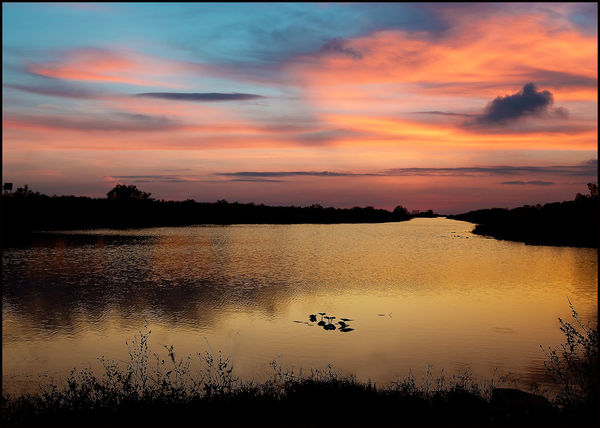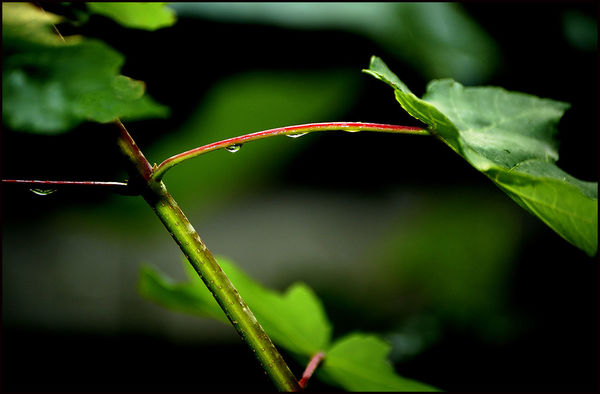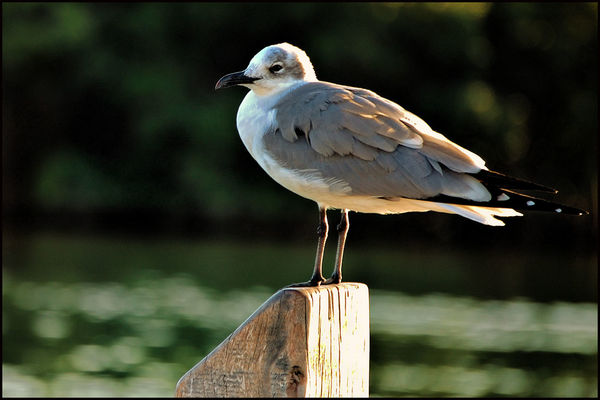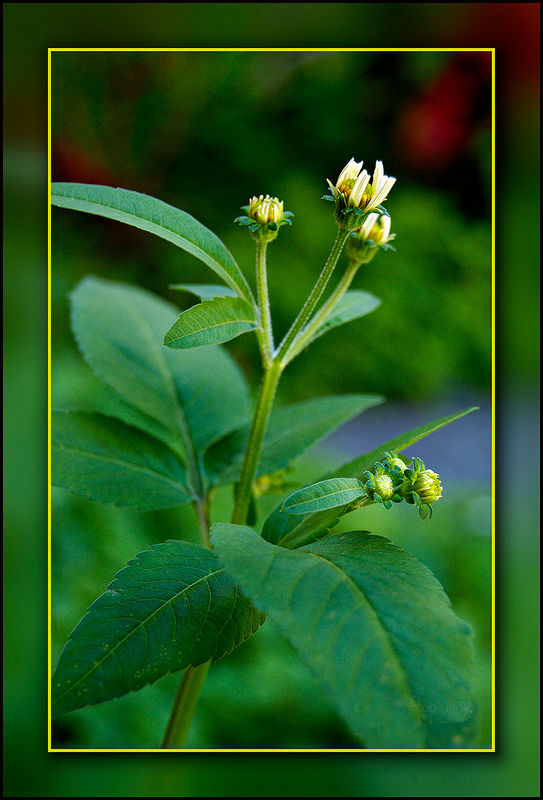The use of kit lenses.
Jun 30, 2021 09:16:25 #
These are all images I have made in the past using kit lenses. I am quoting John Shaw when he said “people think oh, if I had this particular lens I could be a better photographer. “ That is not all, he keeps on saying, “learn to see your subjects and then get the lens that will enable you to get that vision. It is not all about equipment.”
The kit lenses were actually designed as budget lenses for the beginner photographer. We cannot expect the resolution and optical corrections enjoyed by professional lenses and this should be obvious. When used with good photographic techniques those lenses are very capable of good results.
The sunset over the Everglades National Park was photographed with a cheap Tokina lens around 2008, designed as a kit lens at the time. It was shot with a D70s if memory does not fail with the lens set to 24 mm which is the equivalent of using a 36 mm lens with a digital camera that has a sensor with the same dimensions of a 35 mm negative.
The tree branches with raindrops was photographed with the Nikon 55-200. It was shot in Atlanta, Georgia, at my sister’s backyard. It had just finished raining and I ventured out to see what I could photograph. The drops of rain caught my eyes.
The gull was part of a group of them at a local marina perhaps waiting for a fisherman to give them something to eat. She is a “laughing gull” a name that comes from her characteristic call. When her head and upper feathers become black it means these birds are in breeding season. Although common in South Florida during the winter months in the summer they migrate toward the Atlantic Northeast. Photographed with the Nikon 55-200.
The sunset at Key Biscayne was also shot with the 55-200. Sunsets are beautiful here in South Florida during the winter season and this one was shot at Crandon Park Marina, a popular spot for fishermen. The last image of the new flowers was made in the Everglades National Park. For this image I used the Nikon 18-55 lens and got closer to my subject for the close-up simulating a macro lens.
Now, as amateurs, do we need fabulous lenses or a better understanding of our subjects? Keeping our eyes open to see the opportunities that present themselves to our eyes can render better images regardless of the lens we use. Do not misunderstand me, a professional lens I already said resolves more and is optically better corrected than an amateur lens but that lens is worthless in the hands of the inexperienced.
I see many times those of us looking for the sharpest lens to photograph without understanding that sharpness has more to do with us than with the lens itself. The majority of the images posted by our friend from the UK Sylvias, an excellent photographer, are mostly shot with kit lenses and they are fabulous, just look at her posts.
As Jack Dykinga once said: “Concentrate on equipment and you will take technically good photographs. Concentrate on seeing the light magic colors and your images will stir the soul.”
Open your eyes to your subjects, look for the opportunities, simplify, use what you have and you will become a better photographer.
The kit lenses were actually designed as budget lenses for the beginner photographer. We cannot expect the resolution and optical corrections enjoyed by professional lenses and this should be obvious. When used with good photographic techniques those lenses are very capable of good results.
The sunset over the Everglades National Park was photographed with a cheap Tokina lens around 2008, designed as a kit lens at the time. It was shot with a D70s if memory does not fail with the lens set to 24 mm which is the equivalent of using a 36 mm lens with a digital camera that has a sensor with the same dimensions of a 35 mm negative.
The tree branches with raindrops was photographed with the Nikon 55-200. It was shot in Atlanta, Georgia, at my sister’s backyard. It had just finished raining and I ventured out to see what I could photograph. The drops of rain caught my eyes.
The gull was part of a group of them at a local marina perhaps waiting for a fisherman to give them something to eat. She is a “laughing gull” a name that comes from her characteristic call. When her head and upper feathers become black it means these birds are in breeding season. Although common in South Florida during the winter months in the summer they migrate toward the Atlantic Northeast. Photographed with the Nikon 55-200.
The sunset at Key Biscayne was also shot with the 55-200. Sunsets are beautiful here in South Florida during the winter season and this one was shot at Crandon Park Marina, a popular spot for fishermen. The last image of the new flowers was made in the Everglades National Park. For this image I used the Nikon 18-55 lens and got closer to my subject for the close-up simulating a macro lens.
Now, as amateurs, do we need fabulous lenses or a better understanding of our subjects? Keeping our eyes open to see the opportunities that present themselves to our eyes can render better images regardless of the lens we use. Do not misunderstand me, a professional lens I already said resolves more and is optically better corrected than an amateur lens but that lens is worthless in the hands of the inexperienced.
I see many times those of us looking for the sharpest lens to photograph without understanding that sharpness has more to do with us than with the lens itself. The majority of the images posted by our friend from the UK Sylvias, an excellent photographer, are mostly shot with kit lenses and they are fabulous, just look at her posts.
As Jack Dykinga once said: “Concentrate on equipment and you will take technically good photographs. Concentrate on seeing the light magic colors and your images will stir the soul.”
Open your eyes to your subjects, look for the opportunities, simplify, use what you have and you will become a better photographer.
Jun 30, 2021 09:19:03 #
Jun 30, 2021 09:19:47 #
Jun 30, 2021 09:22:37 #
gvarner
Loc: Central Oregon Coast
My Nikon 28-200 is considered a kit lens. I’m perfectly happy with the results.
Jun 30, 2021 09:24:59 #
Nice.
(I cannot understand why "kit" is considered so derogatory by so many people. If the manufacturer put lousy lenses in "kits", word would get around and sales would plummet, as well as their reputation.)
(I cannot understand why "kit" is considered so derogatory by so many people. If the manufacturer put lousy lenses in "kits", word would get around and sales would plummet, as well as their reputation.)
Jun 30, 2021 09:31:24 #
Great images and discussion. Today's 17-55 DX-style lenses, with VR/IS support, are wonderfully sharp lenses. Their issues are less the optics than their relatively cheap build and an inability to last through even moderate rough usage. When you get into full-frame cameras and 'kits' with profession 24-105L lenses, the derogatory 'kit' is either ignorant or worse.
Jun 30, 2021 09:35:38 #
CHG_CANON wrote:
Great images and discussion. Today's 17-55 DX-style lenses, with VR/IS support, are wonderfully sharp lenses. Their issues are less the optics than their relatively cheap build and an inability to last through even moderate rough usage. When you get into full-frame cameras and 'kits' with profession 24-105L lenses, the derogatory 'kit' is either ignorant or worse.
Well said. The only qualifier I can see is that kit lenses are not typically as fast as some of the optional upgrades.
Jun 30, 2021 09:36:11 #
The much maligned "kit" lenses are sometimes optically better than their more costly cousins. Kit lenses tend to have a limited zoom range of 3 or 4 to 1. These lenses can outperform the more costly lenses that have extreme zoom range. Yes, they tend to have pastic lens mounts and lightweight construction, but optically they are not sub par. It's a pretty soild rule of thumb for optical quality...the less zoom range the better.
Jun 30, 2021 09:39:03 #
Jun 30, 2021 10:01:39 #
Thank you gentlemen for your interesting comments. What makes us better photographers are not the optics we use but our vision, our creativity. When John Shaw, a Nikon legend, was asked in one of his workshops about the quality of his images he did not hesitate on saying that using a tripod was always his first step. Remember that Mr. Shaw comes from the film era, when lenses before the 70's were single coated and none of them had image stabilization. I believe in IS but still use my tripods in a majority of cases.
The only kit lens I use today is the excellent Nikon 18-70, a lens that last year quit AF. I continue to use the lens in manual focus. In spite of been a kit lens it has minimal distortions, excellent resolution across all f stops and with its short zoom range and apertures between f3.5 and f4.5 it is capable of excellent images. With my Olympus cameras I use the 40-150 f4-5.6 very often. The "plastic fantastic" has surprised me with its quality. Another excellent kit lens and I call it like that because it has been offered with new cameras is the Nikon 24-120 f4, AF-S, VR. I used to have the first version of this lens that has been called "one of the worst lenses Nikon ever made" and instead in my experience was one of the great lenses I had at the time. I use to shoot weddings with it.
Use what you have.
The only kit lens I use today is the excellent Nikon 18-70, a lens that last year quit AF. I continue to use the lens in manual focus. In spite of been a kit lens it has minimal distortions, excellent resolution across all f stops and with its short zoom range and apertures between f3.5 and f4.5 it is capable of excellent images. With my Olympus cameras I use the 40-150 f4-5.6 very often. The "plastic fantastic" has surprised me with its quality. Another excellent kit lens and I call it like that because it has been offered with new cameras is the Nikon 24-120 f4, AF-S, VR. I used to have the first version of this lens that has been called "one of the worst lenses Nikon ever made" and instead in my experience was one of the great lenses I had at the time. I use to shoot weddings with it.
Use what you have.
Jun 30, 2021 10:06:56 #
Jun 30, 2021 10:10:08 #
kpmac wrote:
I often still use my "kit" lenses. They can deliver great results.


Jun 30, 2021 10:13:48 #
kpmac wrote:
I often still use my "kit" lenses. They can deliver great results.
It is your vision, your techniques and your creativity what produces excellent images. The lens is only a tool. Ansel Adams did not have the lenses we have today and instead his images were of superb quality and still sell for thousands of dollars.
There is nothing wrong with a kit lens and they are disposable when it comes to replace them.
Jun 30, 2021 10:21:41 #
Look at this portrait shot with the Nikon 55-200 kit lens. It is not the best posed portrait but the quality of the image with the lens hand held is there. Look at the bouquet, not bad for a kit lens either.
This young lady is from Brazil, she was visiting and buying used computers for parts in her country. She makes business with one of my sons and usually stays at home with us. Been in a hurry I made a very informal portrait of her which she loved but we know better.
To repeat myself, use what you have.
This young lady is from Brazil, she was visiting and buying used computers for parts in her country. She makes business with one of my sons and usually stays at home with us. Been in a hurry I made a very informal portrait of her which she loved but we know better.
To repeat myself, use what you have.
Jun 30, 2021 10:40:07 #
Back when camera shops were the primary place to buy camera equipment, camera shop salespeople used to love to tell customers that if they are serious about photography, they need to move beyond the kit lens... that the kit lens is not very good and will hold them back. Of course the salespeople made these statements for good reason - to get customers to buy lenses!
Oddly enough, photographers still repeat the words of the salespeople and accept them as hard fact.
Oddly enough, photographers still repeat the words of the salespeople and accept them as hard fact.
If you want to reply, then register here. Registration is free and your account is created instantly, so you can post right away.












